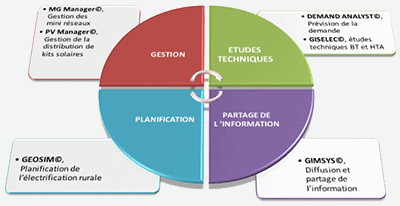NAP - Network Analysis and Planning
NAP allows to analyze and plan the electric transmission network by load flow and stability calculations
Technical optimization:
- Dimensioning of MV/HV networks (lines, compensators, generators ...)
- Analysis of existing networks and identification of weaknesses
- Planning of new distribution and transmission networks
- Planning for reinforcement of existing distribution and transmission networks
- Incident management forecast (criterion N-1)
- Dynamic stability analysis
Economic and financial optimization:
- Loss reduction study
- Minimization of operating costs
- Optimization of production plans and dispatching

NAP is a complete software for the analysis and planning of electrical networks. A single graphical interface groups together several calculation modules:
- Load Flow (ILF)
- Load Flow with constraints (CPF)
- Optimized Load flow (OPF)
- Short circuit (SCC)
- Incident simulation (OUTSIM)
- Stability calculations (STABIL)
State-of-the-art software
NAP is the result of more than 30 years of experience in charge flow modeling, recent mathematical research, and object-oriented programming. Our main goals have always been to develop software:
- Simple to use: No training is required to use the NAP interface because it is based on Windows standards.
- Specific for planning: definition of scenarios, years of switching on and off, as well as load growth.
- Based on reliable, flexible and powerful algorithms.
Graphic representation of the networks
The networks are presented in the form of single-line diagrams. The user can choose the data and results to display on these diagrams. The thickness and color of network elements may depend on the value of any given data or result. Several schemas can be simultaneously displayed on the screen, making it easier to compare different network alternatives. Standard functions such as zooms are of course available.
Interactivity
Drawing a network element (node, transformer, line or DC line) is enough to create it. It is also possible to move it with the mouse. By clicking on an element of the network, a form is opened, presenting the results and making it possible to modify the data. The data are defined in physical units (MW, km,? ...); forgotten conversions to "per unit".
The scenario manager
Scenarios are organized on the principle of inheritance. This means that if the value of a data item is not defined in a scenario, it is equal to that defined in the parent scenario, which can also inherit from its own parent scenario and so on. It is thus possible to define variants by avoiding the copying of data. In planning, scenarios may differ in the value of their technical data or in different investment strategies.
Network Calculation Modules
LOAD FLOW
The optimized load flow is to solve a cost minimization problem whose variables must satisfy the following constraints:
- Equations of charge flows.
- Inequations: operating limits of controllable variables.
The calculation is divided into 3 steps: ILF, CPF and OPF.
ILF - Flow of initial charges
This first step consists of solving a standard power flow problem ignoring the inequality constraints, using the Newton-Raphson mathematical technique.
CPF - Flow with constraints
When the ILF solution does not satisfy the inequalities, the CPF searches in the solution space for a solution that satisfies all the inequalities on the voltages, the generation, the currents and the steps of the transformers. If such a solution does not exist, the violated constraints are highlighted.
OPF - optimized charge flow
This third step consists of finding the power flow solution, which minimises the generators operating cost while not violating the inequality constraints. Due to this powerful approach, the OPF also calculates the marginal costs of real and reactive demand at each node. This information is a powerful help when designing new systems or upgrading existing ones.
SCC - Short circuit
The objective of the Short Circuit simulation is to estimate the status of the generation and transmission system a few voltage cycles after the occurrence of a fault. Transient or sub-transient responses can be analysed. The program simulates symmetrical faults (3 phases to ground) and non-symmetrical faults (1 phase to ground, 2 phases to ground, or phase to phase). The OPF solution is used as the pre-fault status of the system.
OUTSIM - Contingency Analysis
OUTSIM is a N-1 incident simulator, i.e. it simulates lines, transformers and generators outages one by one. Starting from the OPF solution, a full AC power flow simulation is performed in order to predict the impact of outages on branch loading, voltages limits and generation capacity.
STABIL - Transient Stability calculation
STABIL simulates the dynamic behaviour of an electric power system during the first few seconds following a major disturbance of that system (e.g. a short-circuit, the loss of a generator or a major branch opening). The main result is a set of curves describing the evolution of the generator rotor angles during the simulation period (generator swing curves). Additional phenomena can also be studied such as the action of the voltage and speed regulators.
Sensitivity analysis
This module allows to analyze the evolution of any result according to the variation of the value of any data within limits fixed by the user
OTHER FUNCTIONS
- Report Builder: Create your own reports by filtering, selecting, and sorting results.
- Import: XML, IEEE, PSS / E, ASCII, clipboard.
- Backup configurations: reports, drawings ...
- Export reports, graphs, and schemas to other software such as Microsoft® Office.
- Multiple selections of network elements.
- Scripting tools and DDE server.
Minimal configuration
▪ Processor : i3 or higher (i5 recommanded).
▪ RAM : 4 Go (8 Go recommended for Windows 10©).
▪ Screen resolution : 1280 x 1024 or higher.
▪ OS : Windows 7,8,10
▪ Available language: FR / EN
Purchase and maintenance
 Please contact us here for any quotation request or proforma
Please contact us here for any quotation request or proforma
You must connect to your personal account or create a new one to access to maintenance subscriptions -> Click here











